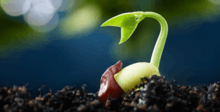Forest reproductive material
Forest reproductive material is a part of a tree that can be used for reproduction such as seed, cutting or seedling. Artificial regeneration, carried out through seeding or planting, typically involves transferring forest reproductive material to a particular site from other locations while natural regeneration relies on genetic material that is already available on the site.[1]

Technical opportunities and challenges to ensure quality and quantity of forest reproductive material can be found in the activities of identification, selection, procurement, propagation, conservation, improvement and sustained production of reproductive material.[2] The use of low quality or poorly adapted forest reproductive material can have very negative impact on the vitality and resilience of a forest.[3]
In Europe, much of the material used for artificial regeneration is produced and transferred within a single country. However, forest reproductive material, usually in the form of seeds or cuttings, is increasingly traded across national borders, especially within the European Union.[1]
Forest reproductive material and climate changes
As a result of climate changes, leading to increasing temperatures,[4] some parts of the current distribution ranges of forest trees are expected to become unsuitable while new areas may become suitable for many species in higher latitudes or altitudes. This will most likely increase the future demand for imported forest reproductive material as forest managers and owners try to identify tree species and provenances that will be able to grow in their land under new climatic conditions.[1] Especially, forest reproductive material with high plasticity will be increasingly useful for this purpose.[5]
References
- Konnert, M.; Fady, B.; Gömöry, D.; A’Hara, S.; Wolter, F.; Ducci, F.; Koskela, J.; Bozzano, M.; Maaten, T.; Kowalczyk, J. (2015). "Use and transfer of forest reproductive material in Europe in the context of climate change" (PDF). European Forest Genetic Resources Programme, Bioversity International, Rome, Italy: xvi and 75 pp. Cite journal requires
|journal=(help) - Marcus, A. & Robbins, J. (2003). "Forest reproductive material: Future opportunities and challenges". Cite journal requires
|journal=(help)CS1 maint: multiple names: authors list (link) - Koskela, J.; Buck, A. & Teissier du Cros, E. (eds) (2007). "Climate change and forest genetic diversity: Implications for sustainable forest management in Europe" (PDF). European Forest Genetic Resources Programme, Bioversity International, Rome, Italy: 111 pp.CS1 maint: multiple names: authors list (link) CS1 maint: extra text: authors list (link)
- Intergovernmental Panel on Climate Change (IPCC), [Core Writing Team: R.K. Pachauri and L.A. Meyer (eds.)]. "Climate Change 2014: Synthesis Report. Contribution of Working Groups I, II and III to the Fifth Assessment Report of the Intergovernmental Panel on Climate Change" (PDF). IPCC, Geneva, Switzerland: 151 p.
- Mátyás, C. (2007). "What do field trials tell about the future use of forest reproductive material?". In: Koskela, J., Buck, A. and Teissier du Cros, E., (eds). Climate change and forest genetic diversity: Implications for sustainable forest management in Europe. European Forest Genetic Resources Programme, Bioversity International, Rome, Italy.: 53–69.